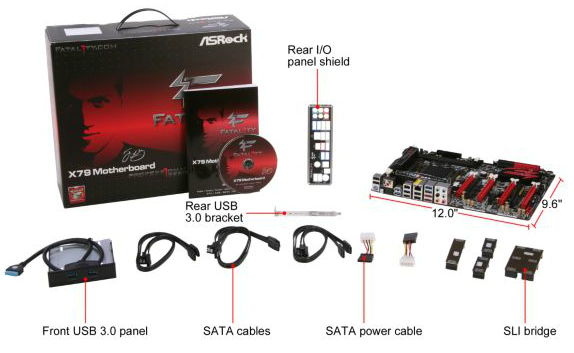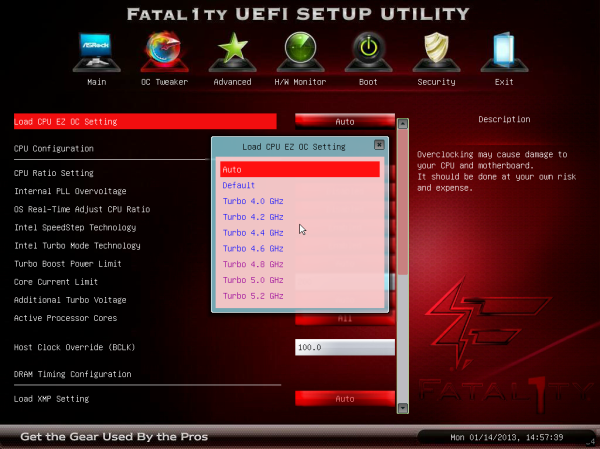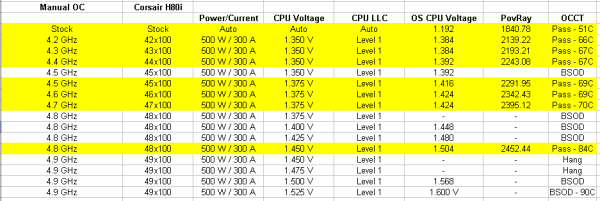ASRock Fatal1ty X79 Champion and X79 Professional Review: From a Gamer to Gamers
by Ian Cutress on February 9, 2013 10:30 AM EST- Posted in
- Motherboards
- ASRock
- Fatal1ty
- X79
ASRock X79 Professional In The Box
As we move down a range of motherboards from a single vendor in terms of price, the only change worth expecting in terms of box contents is usually a decrease in number, or elimination of high-end specific/low-end novelties. At $265, the Professional is still a large investment for any build, meaning we still expect some depth and range in the package itself. Given that the Champion and Professional support 4-way GPU configurations, I would safely assume given what the Champion provided that the Professional will also supply sufficient SLI Bridges.
From the Professional we get:
Driver CD
User Manual
Rear IO Shield
Six SATA Cables
Two Molex to SATA Power Cables
Two 2-slot Rigid SLI Bridges
One 3-slot Rigid SLI Bridge
One 2-slot Rigid 3-way SLI Bridge
USB 3.0 Front Panel with Rear Bracket included

The only difference between the Professional and the Champion is the Professional lacks the 3-slot rigid 3-way SLI bridge because the PCIe layout does not allow such a configuration. Despite this, the motherboard still has four SLI bridges when a single rigid 4-way would have been sufficient for all NVIDIA configurations.
ASRock X79 Professional Overclocking
Experience with Professional X79 Professional
In comparison to overclocking with the Champion, the Professional achieved a higher overclock at a lower voltage and a lower temperature. It feels very weird to say that for two boards that are near identical, the cheaper one offers a better overclocking experience. A possibility for this could relate to the reduction of functionality from the Champion to the Professional, or that the Professional has had more input on the BIOS side (latest versions at testing time was P2.30 for the Professional and P1.90 for the Champion).
Nevertheless, the ASRock boards still fall down on the OS overclock implementation – no list of automatic overclocks from software, and the OC implementations in software are lacking at best, especially when put side by side with the competition, such as ASUS. The BIOS overclocking options are however well laid out, easy to use, and provide a large number of automatic options to help any user on their overclocking journey.
Methodology:
Our standard overclocking methodology is as follows. We select the automatic overclock options and test for stability with PovRay and OCCT to simulate high-end workloads. These stability tests aim to catch any immediate causes for memory or CPU errors.
For manual overclocks, based on the information gathered from previous testing, starts off at a nominal voltage and CPU multiplier, and the multiplier is increased until the stability tests are failed. The CPU voltage is increased gradually until the stability tests are passed, and the process repeated until the motherboard reduces the multiplier automatically (due to safety protocol) or the CPU temperature reaches a stupidly high level (100ºC+). Our test bed is not in a case, which should push overclocks higher with fresher (cooler) air.
Automatic Overclock:
Due to the lack of automatic overclock settings in the OS and software, we delve straight into the BIOS. We are offered overclocks from 4.0 GHz to 5.2 GHz, in 200 MHz intervals – these options recall a pre-programmed table of settings and apply them in the BIOS.
The results are as follows:
The options and settings for the Professional mirror those of the Champion as one would expect, however as noted, the automatic settings on the Professional are stable one notch higher than those of the Champion.
Manual Overclock:
Using the automatic overclock settings as a guide, the following options were selected for the manual overclocks:
Power Limits: 500 W
Current Limit: 300 W
Load Line Calibration: Level 1
PLL Overvoltage: Enabled
Starting at 4.2 GHz and 1.350 volts as set in the BIOS, the system was tested for stability, moving up in multiplier when successful and moving up in voltage when unsuccessful. Our results are as follows:
There are a couple of results worth noting.
On the Professional, the load OS voltage (when using a Load Line Calibration of Level 1) is clearly miles above what is actually set in the BIOS. For example, at our 4.8 GHz stable setting, at load in the operating system showed 1.504 volts, compared to only 1.450 volts in the BIOS. That is a crazy difference, and I have no understanding of why ASRock would program it this way, especially when the Champion by comparison does a near 1:1 application of setting and load.
As a result of our overclocking, the system was successfully stable at a lower range of voltages as set in the BIOS. The Professional was stable at 4.7 GHz with only 1.375 volts in the BIOS (1.424 volts at OS load) compared to the Champion which required 1.525 volts (1.520 volts at OS load). This is a large difference, indicated by a load temperature of 70C on the Professional to 91C on the Champion.













71 Comments
View All Comments
Homeles - Saturday, February 9, 2013 - link
Unfortunately for your pretentious argument, 13 year old kids wouldn't even know who the hell Fatal1ty is.Beenthere - Saturday, February 9, 2013 - link
It doesn't matter who he is, what matters is that 13 year olds (of all ages), THINK he's important and thus they must have the products he endorses.I'm not rsentful at all, I'm educated and not a gullible sheep. I find it amazing the sheeple buy into this stupid marketing crap. It's like the majority of people were born braindead...
Samus - Saturday, February 9, 2013 - link
u mad, bro?CeriseCogburn - Tuesday, February 12, 2013 - link
He's an angry gullible sheep that is spewing the PC correct line of hatred toward "marketing" by a "corp".What is sickening is listening to the whining PC pure sheep who don't realize they are shorned and shunned for being so stupid, themselves.
Iketh - Saturday, February 9, 2013 - link
unfortunately, your rant is just as childish... you only come across as resentfulas for me, I also hate the Fatality branding, but that's because I feel queer every time I have to look at him looking back at me so seductively...
DigitalFreak - Saturday, February 9, 2013 - link
Faetal1tycmdrdredd - Saturday, February 9, 2013 - link
I much prefer the Asus Republic of Gamers (ROG) branding and theme. It's generic, and actually has a solid lineup that is worth the premium over the standard lineup. The Asrock Fatality brand IMO adds lots of bells and whistles that add nothing to the product that screams "worth it".bigboxes - Saturday, February 9, 2013 - link
You share a lot of clueless opinion on this site. 13-year olds can't afford these mobos. Don't like it? Don't buy it. There, was that so hard?N4g4rok - Saturday, February 9, 2013 - link
FINISH HIM.Exodite - Saturday, February 9, 2013 - link
My takeaway from this is that we need more famous electrical engineers.I'd gladly buy a name-branded motherboard from someone with l33t tracing skills and a good eye for component selection.